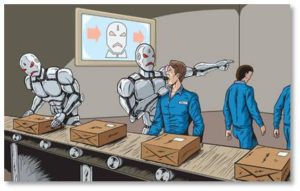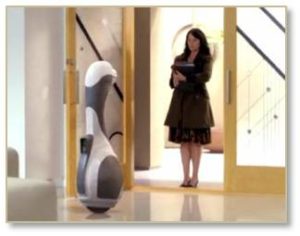 Once, not so very long ago, I and many others worried that millions of Americans would lose their jobs to industrial robots. We imagined long employment lines and crowded soup kitchens as companies replaced expensive workers with far more efficient and cost-effective robots.
Once, not so very long ago, I and many others worried that millions of Americans would lose their jobs to industrial robots. We imagined long employment lines and crowded soup kitchens as companies replaced expensive workers with far more efficient and cost-effective robots.
Boy, were we wrong.
A Dearth of Workers
Not about the robots, mind you. That’s happening at an increasing speed.
No, what we were wrong about was the armies of cast-off employees seeking new jobs without any results. Instead, in this ongoing pandemic, we have a dearth of workers. Susanne chronicled some of the causes in her post “Where Have All the Workers Gone?”
 In addition to that explanation, we know that employees died. Sure, Americans 65 and older account for almost 75% of the nation’s 800,000+ Covid-19 deaths. But that doesn’t mean those people were all retired. As the Boston Globe reports, Baby Boomers in the corner office have been reluctant to step aside and make way for younger executives. Reporter Robert Weisman says,
In addition to that explanation, we know that employees died. Sure, Americans 65 and older account for almost 75% of the nation’s 800,000+ Covid-19 deaths. But that doesn’t mean those people were all retired. As the Boston Globe reports, Baby Boomers in the corner office have been reluctant to step aside and make way for younger executives. Reporter Robert Weisman says,
“Boomers still hold most of the CEO jobs at top public companies, most of the seats in Congress, and most of the votes in the academy that hands out Oscars.”
Still, as William A. Galston says in The Wall Street Journal:
“Before the emergence of Covid-19, the share of Americans 65 and older in the workforce had been increasing steadily. The virus abruptly reversed this trend. Older Americans have left the workforce in droves, and many will never return.”
Supporting the Workforce
While some of those 65-and-over Covid victims may not have held W-2 jobs before their deaths, many provided daycare for their grandchildren so mom and dad could work two or three jobs to make ends meet. Without that family support, more women than men have had to drop out and stay home. The National Women’s Law Center reports the total number of women who have left the labor force since February 2020 as more than 2.3 million. The NWLC puts women’s participation rate in the labor force at 57%, the lowest it’s been since 1988.
 For all those reasons, and probably more we don’t yet know or understand, workers are disappearing. Employees are quitting their jobs for new and better-compensated positions or dropping out of the workforce altogether. This is particularly true of the low-wage, entry-level positions. Mom-and-Pop shops often can’t afford to pay more, though, so they have to cut services, reduce hours, or close for good.
For all those reasons, and probably more we don’t yet know or understand, workers are disappearing. Employees are quitting their jobs for new and better-compensated positions or dropping out of the workforce altogether. This is particularly true of the low-wage, entry-level positions. Mom-and-Pop shops often can’t afford to pay more, though, so they have to cut services, reduce hours, or close for good.
In a different time, new immigrants would have filled this slot, taking the tougher, grittier and worst-paid jobs at the bottom of the ladder. After four years of the Trump administration, however, immigration has dwindled. Those new workers haven’t made it into the country, much less the workforce.
Dropping by Attrition
Big companies are investing in robots to perform the work human beings once did. As Mr. Galston reports in the WSJ, Tyson Foods spent over$70 million this year on automation and expects to spend $1.3 billion in the next three years. Once those mechanisms are in place to perform functions like de-boning chicken, the jobs will be automated forever.
While some people will lose their jobs outright, the workforce will also drop by attrition, as Americans move to other positions and robots fill in behind them.
 Mom-and-Pop stores, restaurants, and service businesses don’t have that kind of money, though, and, even if they did, many of those jobs cannot be easily automated. That leaves nursing homes and assisted-living facilities without the practical nurses, orderlies, janitors, and kitchen workers the need to meet mandated staff-to-patient ratios.
Mom-and-Pop stores, restaurants, and service businesses don’t have that kind of money, though, and, even if they did, many of those jobs cannot be easily automated. That leaves nursing homes and assisted-living facilities without the practical nurses, orderlies, janitors, and kitchen workers the need to meet mandated staff-to-patient ratios.
Restaurants are already reducing hours or closing altogether because they can’t find servers, line chefs and dishwashers. Even big hotels have had to reduce maid service, refresh towels less often, shut down newsstands and eliminate free breakfasts. If you enjoy making your own hotel bed, have at it.
The Employee Drought
If nothing else, this employee drought ought to make clear that immigrants don’t take jobs from Americans. They do the jobs Americans won’t. So, if we don’t have the immigrants and Americans won’t do the work, robots will fill in whenever and wherever possible.
The irony, of course, is that some of the very people who run the Mom-and-Pop businesses that need those immigrants to keep their businesses running economically, are the very people who vote for anti-immigrant candidates. They think they’re protecting American jobs, but they are actually putting themselves out of business.
Our New Robot Workers
These newly mechanized businesses will run efficiently but they may not feel good to the rest of us. We’ll never see the industrial robots chunking away in big manufacturing companies because they don’t interface with customers. But we will notice when we begin dealing with a mechanical workforce in hospitals, hotels, restaurants, and even main-street shops.
We’ll get used to it, of course, in the same way we have adjusted to using kiosks in airports, self-checkout in big-box stores, and scanning a QR code instead of holding a menu. Some of these automated interactions my strike us as no more offensive than an ATM. Others just might leave us cold.
A Hotel Without Staff
 Imagine checking into a hotel with no human beings to register you, give you a room key, answer your questions, or point the way to the elevator. In the coffee shop, you order from a kiosk in the table and your meal arrives via a rolling robot. Self-directed industrial machines vacuum the hallways, wash and polish the tile, and clean the windows.
Imagine checking into a hotel with no human beings to register you, give you a room key, answer your questions, or point the way to the elevator. In the coffee shop, you order from a kiosk in the table and your meal arrives via a rolling robot. Self-directed industrial machines vacuum the hallways, wash and polish the tile, and clean the windows.
In fact, the only people you may encounter during your stay are other guests. When you leave, you walk out to your car because there were no valets to park it. Does that feel welcoming? It gives a whole new meaning to the idea of hospitality.
None of us saw this coming. After decades of companies holding all the power, it feels good to see employees flexing their muscle to improve salaries, benefits, and working conditions. We’re looking at totally new ways of doing business and some of them might be uncomfortable. We will, however, adjust, adapt, and eventually accept.

Greetings. I know this is somewhat off-topic, but I was wondering if you knew where I could get a captcha plugin for my comment form? I’m using the same blog platform like yours, and I’m having difficulty finding one? Thanks a lot.
Leonardo: Add reCaptcha to your plugins and activate it.
A couple of points I’d like to make please:
1. I just read today for the first time that the majority of those that quit their respective jobs in just the last month (more than 3 million!) ~ 90% were 55 or older and simply took retirement and bailed out.
2. Although robots are doing more all the time, it is most difficult to apply them to more than very menial and repetitive tasks today which will very likely continue well into this decade and more. Jobs like packing boxes or transferring items from one location to another are typically very good applications that most low wage workers really wouldn’t want anyway. Some still do however.
3. A lot of companies both large and small, are now realizing, and actually providing training or other suitable education to bring people in to fill roles that they simply can’t find qualified people willing and able to fill these jobs otherwise. In this time of pandemics, this could be a new trend, but I doubt anyone knows for certain as yet.